"We are what we repeatedly do. Excellence, then, is not an act, but a habit." --Aristotle
Address any questions or comments regarding this newsletter to the individual authors listed after each article or to its editor, Rick Weinzierl, 217-333-6651, weinzier@illinois.edu. To receive e-mail notification of new postings of this newsletter, call or write the same number or address.
In This Issue:
Upcoming Programs (for beginning and established growers)
Regional Reports (from western Illinois)
Fruit Production and Pest Management (new fungicide for fruit and vegetable disease management; periodical cicadas next month in northwestern IL; lesser peachtree borer; pheromone trap data and phenology models for codling moth and oriental fruit moth)
Vegetable Production and Pest Management (survival of winter vegetables in low tunnels in central IL)
Local Foods Issues (August 2014 deadline for food safety cost-share audits)
Upcoming Programs
Check the Illinois SARE calendar for a full list of programs and links for registration.
http://illinoissare.org/ and http://illinoissare.org/calendar.php
Also see the University of Illinois Extension Local Food Systems and Small Farms Team’s web site at:
http://web.extension.illinois.edu/smallfarm/ and their calendar of events at http://web.extension.illinois.edu/units/calendar.cfm?UnitID=629.
- GAPs (Good Agricultural Practices) webinars, June, 2014. See https://web.extension.illinois.edu/units/event.cfm?EventID=64548&UnitID=472 for more information on webinar dates and registration, or contact a Local Food Systems and Small Farms educator in your area (see the staff list and contact info at the end of this newsletter).
- Fruit Tree Grafting Workshops, April 26 2014. Livingston County. See http://web.extension.illinois.edu/registration/?RegistrationID=9119 or contact Bill Davison at 309-663-8306 or wdavison@illinois.edu for information. Registration fee is $10.00.
- GAPs (Good Agricultural Practices) Workshop, April 29, 2014, Arturo Velasquez Institute, Chicago, IL. See http://web.extension.illinois.edu/cook/localfoods.html or contact Ellen Phillips at ephillps@illinois.edu or 708-449-4320.
- SW Illinois Orchard Twilight Meeting, May 15, 2014. Tom Ringhausen Orchard, Batchtown, IL. Program begins at 5:30 p.m. and will include discussions led by UI Extension on early season insect and disease management in fruit crops. For additional details or questions, contact Andrew Holsinger at aholsing@illinois.edu or 217-532-3941.
- Illinois Summer Horticulture Field Day, June 12, 2014. Schwartz Orchard, Centralia, IL. See www.schwartzfruitfarm.com and/or www.specialtygrowers.org for more information. For reservations, see www.ilsthortsoc@yahoo.com or phone 309/828/8929.
Regional Reports
From western Illinois (Friday, April 18) ... Warmer weather is on the way for the Easter weekend, but the week of April 14 has been another cold one here (Galesburg area). As I write this, the 4-inch soil temp is only 41 degrees.
I had the opportunity to be on a number of farms this week, and apricot and cherry trees are breaking bud. One grower noted that they were doing so on the same day that the evening temperature got down to 27 degrees. Asparagus is on the verge of being harvested, and some damage was noted with the same 27 degree temps during the week. Growth in area high tunnels is impressive. Arugula and similar greens are abundant. Most growers are simply waiting to get into the fields, as transplants are ready to go.
I noted in earlier messages that I was on the fence regarding how the garlic crop would make it through this last winter. Once again, I am impressed at how hardy some vegetable crops are. Garlic is coming along well, and across the board does not seem to be adversely affected by the extremes we experienced in temps this past winter.
Kyle Cecil (309-342-5108; cecil@illinois.edu)
Fruit Production and Pest Management
New Fungicide for Fruit and Vegetable Crops
Fontelis 1.67 SC is a new fungicide, available for control of diseases of vegetable and fruit crops. Fontelis 1.67 SC (20.4% penthiopyrad), manufactured by DuPont, is a broad-spectrum fungicide recommended for control of foliar and soil-borne plant diseases. It has preventive, curative, and locally systemic activity and is listed in Group 7 for mode of action (FRAC code 7).
Fontelis can be used for control of fungal diseases of Brassica vegetables, cucurbits, fruiting vegetables (peppers and tomatoes), leafy vegetables (celery, lettuce, spinach), legume vegetables, strawberries, blueberries, pome fruits (apple and pear), and stone fruits. Fontelis has also been registered for control of diseases of nut crops. For more information on Fontelis 1.67 SC, see http://www.cdms.net/LDat/ldAHH003.pdf.
Efficacy evaluations of Fontelis in Illinois have shown that this fungicide is very effective for control of powdery mildew of cucurbits; scab, powdery mildew, and rusts of apple; and leaf spots of horseradish. Based on the reports from other states, mixing Fontelis with Captan should be avoided, as it might cause phytotoxicity (e.g., leaf injury of apples).
Mohammad Babadoost (217-333-1523; babadoos@illinois.edu)
Brood III of 17-year Periodical Cicadas to Emerge in Iowa and Northwestern Illinois in May
In mid- to late May of this year, Brood III of the 17-year periodical cicadas in the genus Magicicada will emerge in Iowa and northwestern Illinois. Magicicada septendecim, M. cassini, and M. septendecula are all found in this brood.
Growers with new young fruit trees will need to protect them where populations are high. Adult cicadas do not feed on fruit trees, but female cicadas cut slits into small twigs to lay eggs ... nymphs that hatch from the eggs drop to the ground to feed on plant roots, but their feeding does not reduce plant performance. It is the egg-laying slits that kill twigs and interfere with training efforts. Covering small trees with cheese cloth or materials used for floating row covers can exclude egg-laying females. Pyrethroids are the most effective insecticides for killing cicadas on small trees, but damage will occur despite their use.
For southern Illinois growers, a forewarning ... in 2015, Brood XXIII will emerge in southern Illinois and surrounding areas. This brood, containing Magicada neotredecim and M. tredecim, will cause serious damage to fruit trees, especially young trees.
For more information on periodical cicadas, see http://www.magicicada.org/magicicada_2014.php.

Left: Distribution of Brood III of the 17-year periodical cicada that will emerge in late May of 2014 in Iowa and northwestern Illinois. Right: Distribution of Brood XXIII of the 13-year periodical cicada that will emerge in 2015 in the lower Midwest.
Rick Weinzierl (217-244-2126; weinzier@illinois.edu)
Monitoring and Controlling Lesser Peachtree Borer in Peaches

Left: Lesser peachtree borer adults (Cornell University). Right: Lesser peachtree borer larvae (West Virginia University).
Lesser peachtree borer flight will likely begin in the next 2 to 3 weeks in southern and central Illinois. The March 27, 2014, issue of this newsletter (use the link to Volume 19 and choose this issue at http://ipm.illinois.edu/ifvn/) discussed the use of pheromone traps to monitor flights. In orchards where this insect has been a moderate to severe problem, the time to apply the first of 2 sprays to trunks and scaffold branches is about a week after traps begin to catch a few lesser peachtree borer male moths on a consistent basis. A second application can be made in August after a summer flight peak; that application usually provides (greater) peachtree borer control as well. Lorsban 4EC is effective against lesser peachtree borer, providing 6 weeks or more of control. Other insecticides labeled for use as trunk and scaffold-branch sprays include the pyrethroids (Pounce, Asana, Warrior, Baythroid, and Renounce); see pp 41-43 of the 2014 Midwest Tree Fruit Spray Guide (https://store.extension.iastate.edu/Product/2014-Midwest-Tree-Fruit-Spray-Guide ... download the pdf) for more details. Mating disruption is an effective alternative to trunk sprays for lesser peachtree borer and (greater) peachtree borer control and may be used in organic production. Use Isomate PTB Dual at label rates ... this product is available from Great lakes IPM in Vestaburg, Michigan (800-235-0285; www.greatlakesipm.com).
Rick Weinzierl (217-244-2126; weinzier@illinois.edu)
Pheromone Trap Data and Phenology Models for Major Tree Fruit Insects
For all growers who are using pheromone traps to monitor codling moth, oriental fruit moth, San Jose scale, lesser peachtree borer, and (greater) peachtree borer in Illinois ... if you send me your early season trapping records and/or biofix dates for these insects, I will use them in conjunction with degree-day models and weather data from the Illinois State Water Survey’s Degree-Day Calculator site to provide regular updates on the seasonal progression of these pests in future issues of this newsletter. If you’re willing to volunteer this information, simply email it to me or call me.
Rick Weinzierl (217-244-2126; weinzier@illinois.edu)
Vegetable Production and Pest Management
Cutworms on High-tunnel Tomatoes
Rick Foster and Dan Egel of Purdue University published a note on claybacked cutworms damaging tomatoes in high tunnels at Vincennes, IN, in last week’s edition of Purdue’s Vegetable Crops Hotline (http://www.btny.purdue.edu/Pubs/vegcrop/VCH2014/VCH580.pdf). This cutworm and a few others overwinter as larvae, and their survival varies with habitat and the severity of the winter. Even in cold winters, high tunnels help to buffer conditions and allow increased survival. Be sure to monitor plantings in high tunnels for insect infestations, even at this early stage of the season.
Rick Weinzierl (217-244-2126; weinzier@illinois.edu)
Winter Survival of Low Tunnel Crops in McLean County
Farmer bred crops selected for cold hardiness proved to be surprisingly hardy when protected by a low tunnel in November of 2013. Most of the crops that I planted in the fall of 2013 survived our long cold winter. This note summarizes winter survival and mid-March appearance and eating quality of crops planted in a low tunnel in McLean county. The initial report for this project that details varieties, methods, and planting dates can be found at http://ipm.illinois.edu/ifvn/contents.php?id=36. Sources for cold hardy vegetables used in this study are: FEDCO Seeds, Adaptive Seeds, Wild Garden Seeds, Uprising Seeds, and Johnny’s Seeds.
One clear trend that this winter revealed is that young crops survive cold better than older crops. Most of the late August plantings died completely, but the mid- to late September plantings had much higher survival rates. The hardiest crops all had near 100 percent survival and minimal cold damage. These include: Mache, Claytonia, Ice Bred Arugula, Chinese thick stem Mustard, Approvecho Hardy Turnip, and Even Star Tatsoi. The Approvecho Hardy Turnip survived the winter and had crisp, solid roots with good eating quality. Only the top ¼ inch of some of the roots were damaged by the cold. The roots were not mulched and the top half of each root was above the soil line. Of the 8 varieties of lettuce planted, 3 stood out as having the highest rates of survival over winter. Winter Marvel had 50 percent of the plants survive. Briweri lettuce had 75 percent survival and North Pole lettuce had 100 percent survival. All three of these are green bibb types known for winter hardiness.
These results confirm that low tunnels have tremendous potential for season extension in central Illinois. Their relatively low cost and flexibility make them a valuable addition for growers who are already using high tunnels. Using cold hardy varieties and planting at the appropriate time can lead to early spring harvests and the ability to overwinter crops such as Walla Walla onions. A good starting point for planning succession plantings is Eliot Coleman’s book The Winter Harvest Handbook. Under extended cold conditions like we had this winter, it is not possible to harvest greens during the coldest part of the winter. The benefit comes from late fall harvests and early spring harvests. In a mild winter it is possible to harvest the hardiest greens all winter. All the greens have increased levels of sugar in their leaves and remarkably sweet flavor. The leaves tend to be thicker and softer than when grown in warm weather. This time of year arugula loses its bite, becomes more mellow, and has a more balanced flavor profile.
Variety |
Planting Date |
Percent Survival |
Notes |
|---|---|---|---|
Evergreen Hardy White Onion |
8-23-13 |
100 |
Plants are 8 inches tall and growing. |
Vates Kale |
8-23-13 |
100 |
Plants are 12 tall and growing. |
Approvecho Hardy Turnip |
8/23 |
90 |
Roots are crisp and sound with good eatin. quality. |
Cornet de Bourdeaux Escarole |
8/26 |
25 |
6 inch rosettes have dead outer leaves but ar. re-growing from the center |
Pokey Joe Cilantro |
8/26 |
100 |
Plants are a beautiful shiny dark green color an. have good eating quality. |
Salad Mix |
9/6 |
50 |
Red Russian kale, endive, and escarole survive. better than lettuce. |
Regular Arugula |
9/6 |
10 |
Standard arugula from Johnny’s Seeds |
Pokey Joe Cilantro |
9/6 |
100 |
Beautiful plants |
Cornet de Bordeaux Escarole |
9/6 |
25 |
6 inch rosettes, some tipburn. |
Brown Golding and Manoa Lettuce |
9/6 |
0 |
Plants reached ½ size and died over winter. |
Briweri Lettuce |
9/6 |
50 |
|
Winter Density |
9/13 |
25 |
4 inch diameter plants, outer leaves are damaged. |
Winter Marvel |
9/13 |
50 |
4 inch diameter plants, outer leaves are damaged. |
Briweri Lettuce |
9/13 |
75 |
Beautiful round 6 inch bibb type plant with minima. damage on outermost leaves. |
North Pole |
9/13 |
100 |
Very similar to Briweri |
Brown Golding, Red Tinged Winter, and Roug. D’hiver |
9/13 |
0 |
No survivors |
Chinese Thick Stem Mustard, Even Star Tatsoi, Ic. Bred Arugula, Mache (Vit), Claytonia |
9/13 |
100 |
All varieties had 100 percent survival an. minimal damage from cold. |
Bill Davison (309-663-8306; wdavison@illinois.edu)
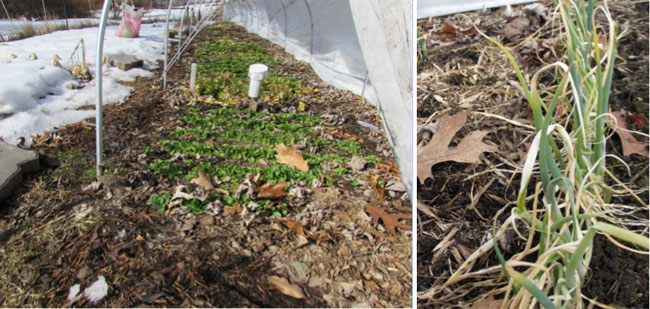
Left: A low tunnel in mid-March after being opened up for the first time in 4 weeks. Mache and the temperature sensor are in the foreground. Right: Evergreen hardy white onions.
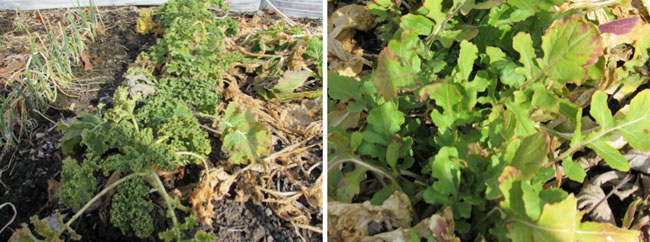
Left: Vates Kale in mid-March. Right: Ice Bred Arugula mid-March.
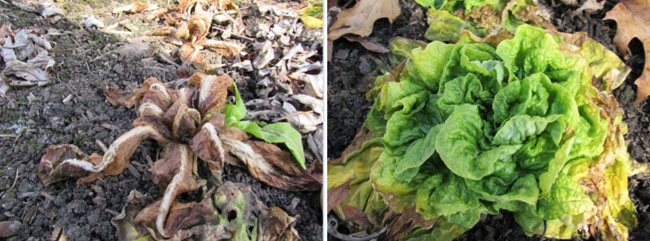
Left: Brown Golding Lettuce did not survive the winter. Right: North Pole Lettuce had 100 percent survival.
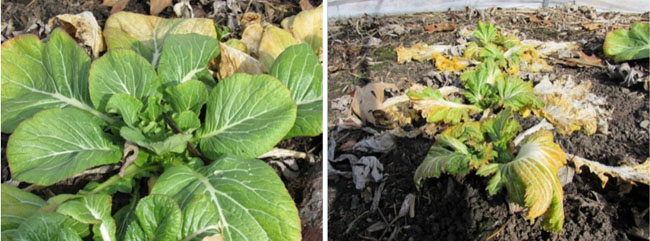
Left: Even' Star Tatsoi is a farmer-bred version of Tatsoi with improved cold hardiness and vigor. Right: Chinese Thick Stem Mustard from Even' Star Farm.
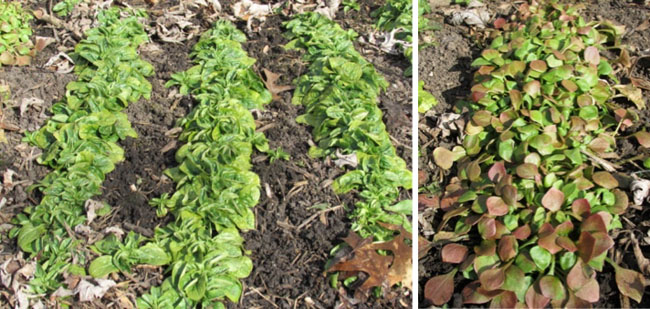
Left: Mache is one of the hardiest winter greens and it survived the winter without being damaged by the extreme cold. Right: Claytonia is another very hardy winter green that survived without being damaged.
Local Foods Issues
August 2014 Deadline for Cost-Share Funds for GAPs Audits
Apply for your audit now to receive up to 75% of the cost of the food safety inspection. The Illinois Department of Agriculture’s Food Safety Grant that assists farmers with a cost-share for GAPs audits will terminate in September 2014. There are still funds available for cost-sharing your audit expenses. Many growers have gone through Good Agricultural Practices (GAPs) Training and are awaiting to hear how the Food Safety Modernization Act (FSMA) will impact farms, especially small farms. The implementation of new rules is scheduled for next year, this cost-share benefit will not be available then. We encourage you to apply to be audited this summer and request the cost-share. The application form is at http://web.extension.illinois.edu/smallfarm/downloads/50983.pdf. If you know you will be seeking a cost-share please contact your Local Food Systems and Small Farms educator now.
Ellen Phillips (708-449-4320; ephillps@illinois.edu) and James Theuri (815-933-8337; jtheu50@illinois.edu)
Less Seriously ...
Several churches in a small town tried to get rid of their pesky squirrel populations. The Presbyterians met and prayed and decided to do nothing; they shouldn’t interfere with God’s divine will. The Baptists covered the baptistery where the squirrels had taken up residence, hoping the animals would drown. They escaped, and there were twice as many squirrels the next week. The Methodists met and decided they had no right to interfere with God’s creation. So they trapped the squirrels and moved them to a new location. Three days later, all the squirrels were back. The Catholics were the smartest. They baptized all the squirrels and made them members of the church. Now they only see them on Christmas and Easter. The Jewish synagogue held a short service called circumcision with one squirrel and they haven’t seen a single squirrel since.
University of Illinois Extension Specialists in Fruit and Vegetable Production & Pest Management
Extension Educators – Local Food Systems and Small Farms |
||
Bronwyn Aly, Gallatin, Hamilton, Hardin, Pope, Saline, and White counties |
618-382-2662 |
|
Katie Bell, Franklin, Jackson, Perry, Randolph, & Williamson counties |
618-687-1727 |
|
Sarah Farley, Lake & McHenry counties |
847-223-8627 |
|
Nick Frillman, Woodford, Livingston, & McLean counties |
309-663-8306 |
|
Laurie George, Bond, Clinton, Jefferson, Marion, & Washington counties |
618-548-1446 |
|
Zachary Grant, Cook County | 708-679-6889 | |
Doug Gucker, DeWitt, Macon, and Piatt counties |
217-877-6042 |
|
Erin Harper, Champaign, Ford, Iroquois, and Vermillion counties |
217-333-7672 |
|
Grace Margherio, Jackie Joyner-Kersee Center, St. Clair County |
217-244-3547 |
|
Grant McCarty, Jo Daviess, Stephenson, and Winnebago counties |
815-235-4125 |
|
Katie Parker, Adams, Brown, Hancock, Pike and Schuyler counties |
217-223-8380 |
|
Kathryn Pereira, Cook County |
773-233-2900 |
|
James Theuri, Grundy, Kankakee, and Will counties |
815-933-8337 |
|
Extension Educators – Horticulture |
||
Chris Enroth, Henderson, Knox, McDonough, and Warren counties |
309-837-3939 |
|
Richard Hentschel, DuPage, Kane, and Kendall counties |
630-584-6166 |
|
Andrew Holsinger, Christian, Jersey, Macoupin, & Montgomery counties |
217-532-3941 |
|
Extension Educators - Commercial Agriculture |
||
Elizabeth Wahle, Fruit & Vegetable Production |
618-344-4230 |
|
Nathan Johanning, Madison, Monroe & St. Clair counties |
618-939-3434 |
|
Campus-based Extension Specialists |
||
Kacie Athey, Entomology |
217-244-9916 |
|
Mohammad Babadoost, Plant Pathology |
217-333-1523 |
|